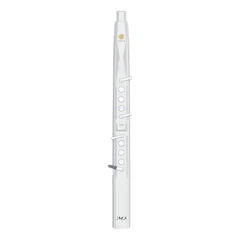An electronic saxophone, like other digital wind instruments (DWIs), operates by translating the player's breath and finger movements into electronic signals that control sound synthesis. Here's a step-by-step explanation of how an electronic saxophone works:
Breath Input:
The player blows into a mouthpiece, which is equipped with sensors to detect the airflow and its intensity.
Breath Sensors:
These sensors convert the breath pressure into electronic signals that correspond to the dynamics of the sound-louder with stronger breath, softer with gentler breath.
Keypads and Fingerings:
The electronic saxophone has a set of keys similar to those on a traditional saxophone. When the player presses these keys, it alters the pitch of the sound produced, just like closing and opening holes on a saxophone.
MIDI Signal Generation:
The combination of breath control and keypad fingerings generates MIDI signals, which are a universal digital language for music communication.
Sound Synthesis:
The MIDI signals are sent to a sound module or a digital audio workstation (DAW) that contains the synthesizer engine. This engine uses the MIDI data to produce sound through its internal samples or synthesis algorithms.
Sound Modification:
Many electronic saxophones have built-in sound modification features, such as reverb, equalization, and other effects, which can be adjusted in real-time by the player.
Audio Output:
The synthesized sound is then output through a speaker or headphones. Some electronic saxophones have built-in speakers, while others may require external amplification.
Connectivity:
Electronic saxophones can be connected to external devices via MIDI or USB, allowing for integration with music production software and hardware.
Expression and Control:
Players can control various aspects of the sound, such as pitch bend, modulation, and articulation, through breath control and the use of expression pedals or other controllers.
Programmability:
Advanced electronic saxophones often allow users to program and save custom settings, sounds, and performance parameters.
Wireless Capability:
Some models offer wireless connectivity, which can be beneficial for live performances by reducing the need for cables.
Rechargeable Battery:
Many electronic saxophones are powered by rechargeable batteries, providing a portable and cord-free playing experience.
Electronic saxophones provide a bridge between traditional wind instrument techniques and modern electronic music technology, offering musicians a wide range of creative possibilities for sound production and performance.
SUNRISE MELODY XR3000 electronic saxophone EWI
Are you seeking a fun and effortless way to master a new EWI electronic wind instrument? Search no more. Tailored for beginners and amateur musicians, the SUNRISE MELODY XR3000 electronic saxophone EWI provides you with an enjoyable musical adventure.
Does learning a new fingering seem overly time-consuming for you? With the SUNRISE MELODY XR3000 electronic saxophone EWI , you merely need to master one fingering, and you'll gain access to a collection of 66 timbres. This simplifies the learning procedure and enables you to play music more rapidly.
Wish to boost your performance or practice more productively? The SUNRISE MELODY XR3000 electronic wind instrument saxophone comes with Bluetooth connectivity, enabling you to link the instrument to your phone or tablet. Play accompaniments during your performance, or make use of a sheet music scanner for practice sessions.



